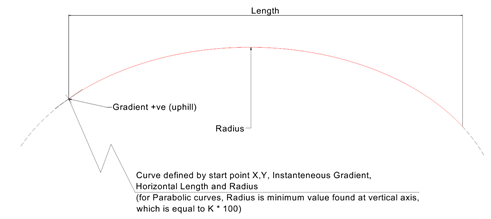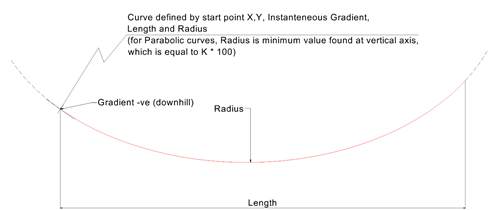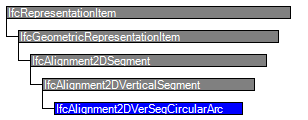Natural language names
 | Alignment 2D Vertical Segment Circular Arc |
Change log
| Item | SPF | XML | Change | Description | IFC4x1 Final 4.1.0.0 |
|---|---|---|---|---|
| IfcAlignment2DVerSegCircularArc | ADDED | IFC4x1 Final 4.1.0.0 | ||
| IfcAlignment2DVerSegCircularArc | ADDED |
Semantic definitions at the entity
Entity definition
The vertical circular arc segment is defined as an arc using the inherited attributes from IfcAlignment2DVerticalSegment and the following additional curve parameters Radius as the radius of the circular arc, and IsConvex to indicate the whether the circular arc defines a sag (i.e. concave, increasing gradiant) or a crest (i.e. convex, decreasing gradiant).
The circular arc is described by:
- x = offset as length measure relative to start of curve segment (i.e. 0 is at head).
- g1 = StartGradient as ratio measure
- R = Radius as length measure
For crest curves (where IsConvex is True), the elevation of a point along the curve (relative to StartHeight) is defined as:

 | start point provided by StartDistAlong and StartHeight instanteneous gradient provided by StartGradient, and length provided by HorizontalLength |
Figure 305 — Alignment vertical arc segment convex |
For sag curves (where IsConvex is False), the elevation of a point along the curve (relative to StartHeight) is defined as:

 | start point provided by StartDistAlong and StartHeight instanteneous gradient provided by StartGradient, and length provided by HorizontalLength |
Figure 306 — Alignment vertical arc segment concave |
Attribute definitions
| # | Attribute | Type | Cardinality | Description | G |
|---|---|---|---|---|---|
| 8 | Radius | IfcPositiveLengthMeasure | radius of the circular arc | X | |
| 9 | IsConvex | IfcBoolean | Orientation of the circular arc, convex (Boolean=”true”) means decreasing gradient along the arc at the beginning such as at the crest of a hill, concave (Boolean=”false”) means increasing gradient along the arc at the beginning such as at the base of a valley. | X |
Inherited definitions from supertypes
Entity inheritance

Attribute inheritance
| # | Attribute | Type | Cardinality | Description | G |
|---|---|---|---|---|---|
| IfcRepresentationItem | |||||
| LayerAssignment | IfcPresentationLayerAssignment @AssignedItems | S[0:1] | Assignment of the representation item to a single or multiple layer(s). The LayerAssignments can override a LayerAssignments of the IfcRepresentation it is used within the list of Items.
IFC2x3 CHANGE The inverse attribute LayerAssignments has been added. IFC4 CHANGE The inverse attribute LayerAssignment has been restricted to max 1. Upward compatibility for file based exchange is guaranteed. | X | |
| StyledByItem | IfcStyledItem @Item | S[0:1] | Reference to the IfcStyledItem that provides presentation information to the representation, e.g. a curve style, including colour and thickness to a geometric curve.
IFC2x3 CHANGE The inverse attribute StyledByItem has been added. | X | |
| IfcGeometricRepresentationItem | |||||
| IfcAlignment2DSegment | |||||
| 1 | TangentialContinuity | IfcBoolean | ? | Connectivity between the continuous segments is not enforced per se to be tangential. Setting "TangentialContinuity" to True means that the current segment shall continue with tangential continuity to the previous one. | X |
| 2 | StartTag | IfcLabel | ? | Tag to annotate the start point of the alignment segment. | X |
| 3 | EndTag | IfcLabel | ? | Tag to annotate the end point of the alignment segment. | X |
| IfcAlignment2DVerticalSegment | |||||
| 4 | StartDistAlong | IfcLengthMeasure | Distance along the horizontal alignment, measured along the IfcAlignment2DHorizontal given in the length unit of the global IfcUnitAssignment. | X | |
| 5 | HorizontalLength | IfcPositiveLengthMeasure | Length measured as distance along the horizontal alignment of the segment. | X | |
| 6 | StartHeight | IfcLengthMeasure |
Elevation in Z of the start point relative to the IfcAlignment coordinate system.
NOTE It is strongly advised to not offset the IfcAlignment coordinate system from the project engineering coordinate system. | X | |
| 7 | StartGradient | IfcRatioMeasure |
Gradient of the tangent of the vertical segment at the start point. It is provided as a ratio measure. The ratio is percentage/100 (0.1 is equal to 10%). It has a theoretical range of -∞ < n < ∞ using a ratio measure. The equivalent range measured in degree is -90° < n < 90°.
NOTE For practical application of start gradient, the range of the ratio measure should be within the limits of -1 ≤ n ≤ 1 (equivalent in degree -45° ≤ n ≤ 45°). However larger limits might apply for particular usages.Positive gradient means an increasing height at the start (or uphill), a negative gradient means decreasing height at the start (or downhill). | X | |
| ToVertical | IfcAlignment2DVertical @Segments | S[1:1] | X | ||
| IfcAlignment2DVerSegCircularArc | |||||
| 8 | Radius | IfcPositiveLengthMeasure | radius of the circular arc | X | |
| 9 | IsConvex | IfcBoolean | Orientation of the circular arc, convex (Boolean=”true”) means decreasing gradient along the arc at the beginning such as at the crest of a hill, concave (Boolean=”false”) means increasing gradient along the arc at the beginning such as at the base of a valley. | X | |
Formal representations
XML Specification
<xs:element name="IfcAlignment2DVerSegCircularArc" type="ifc:IfcAlignment2DVerSegCircularArc" substitutionGroup="ifc:IfcAlignment2DVerticalSegment" nillable="true"/>
<xs:complexType name="IfcAlignment2DVerSegCircularArc">
<xs:complexContent>
<xs:extension base="ifc:IfcAlignment2DVerticalSegment">
<xs:attribute name="Radius" type="ifc:IfcPositiveLengthMeasure" use="optional"/>
<xs:attribute name="IsConvex" type="ifc:IfcBoolean" use="optional"/>
</xs:extension>
</xs:complexContent>
</xs:complexType>
EXPRESS Specification
ENTITY IfcAlignment2DVerSegCircularArc
SUBTYPE OF (IfcAlignment2DVerticalSegment);
Radius : IfcPositiveLengthMeasure;
IsConvex : IfcBoolean;
END_ENTITY;

 EXPRESS-G diagram
EXPRESS-G diagram Link to this page
Link to this page